What to See and Do in Granada in 2 Days - A Local's Insider Weekend Guide
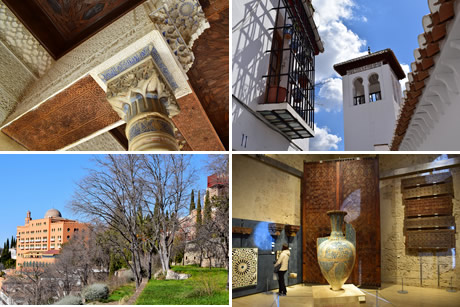
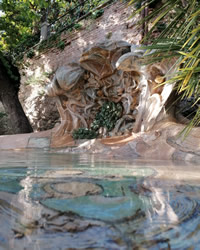
Enjoy a special day at the Alhambra with a guided tour
 Alhambra and Nasrid Palaces: discover the wonders of the Alhambra with this all-inclusive tour: the Nasrid Palaces, the Generalife, the Alcazaba, and more.
Alhambra and Nasrid Palaces: discover the wonders of the Alhambra with this all-inclusive tour: the Nasrid Palaces, the Generalife, the Alcazaba, and more.
 Alhambra + Albaicín + Sacromonte: a perfect combination of a guided tour of the Alhambra in the morning and a guided tour of the Albaicin and Sacromonte in the afternoon.
Alhambra + Albaicín + Sacromonte: a perfect combination of a guided tour of the Alhambra in the morning and a guided tour of the Albaicin and Sacromonte in the afternoon.To help you make the most of your time, we've put together this itinerary so you don't miss anything interesting. Naturally, you can adjust it to suit your needs.
This plan shows the top sights and some secret spots. We've also included tips to help you avoid tourist traps, discover the best places to eat, and find the best route to each attraction.
Granada Day One Itinerary: What to See and Do
On the first of two days in Granada, we begin with the Alhambra, famous for its rich history and stunning beauty. It's best to visit it first before continuing with the rest of your day.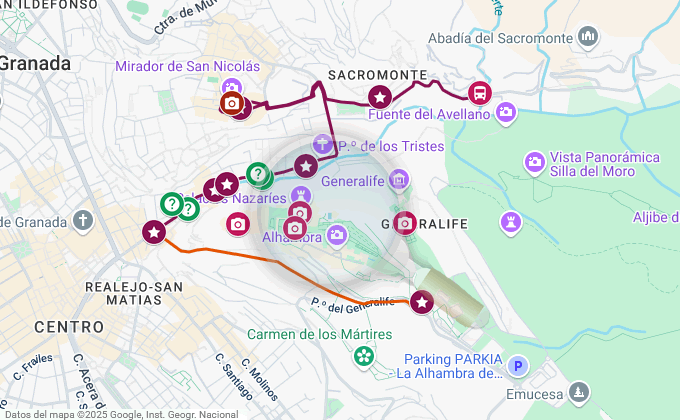
It's also located not far from the centre of the city, offering a good starting point to explore other attractions, such as going down the hill for a 10-minute walk through the Alhambra forest to Plaza Nueva and Carrera del Darro.
The Alhambra – Jewel of Moorish Art
This impressive monument, which functioned as both a palace and a fortress, was built during the Nasrid dynasty around 1238, under the rule of Muhammad I.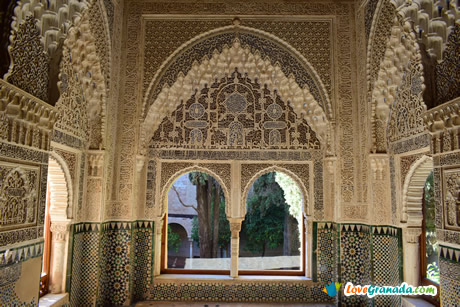 A true masterpiece of Islamic architecture, the Alhambra transports visitors to another era.
Its beautiful mosaic decorations, courtyards with fountains, and lush gardens leave you totally speechless.
A true masterpiece of Islamic architecture, the Alhambra transports visitors to another era.
Its beautiful mosaic decorations, courtyards with fountains, and lush gardens leave you totally speechless.
Nasrid Palaces
The Alhambra is divided into three main sections, each with its own distinct style and purpose. The most breathtaking of these is the Nasrid Palaces, which once served as the residence of the sultans of the Nasrid dynasty, the last Muslim rulers of the Iberian Peninsula.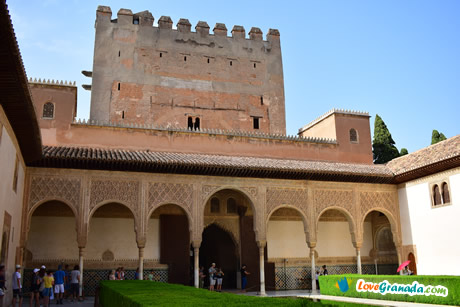 Each section stands as a masterpiece in its own right, narrating a story through its architecture and elaborate details.
Each section stands as a masterpiece in its own right, narrating a story through its architecture and elaborate details.
The Patio de los Arrayanes is particularly striking, with its central pool reflecting the sky and the towers that rise majestically from its waters.
The Patio de los Leones, the very heart of the palace, is home to twelve marble lions surrounding a central fountain, a true masterpiece of Nasrid art and design.
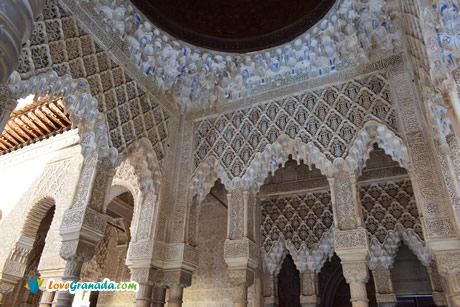 Moving on, you'll enter the Comares Palace, where each room is adorned with exquisite tiles and intricate plasterwork.
The Throne Room was the grand hall where the Nasrid monarch received important figures, from subjects to ambassadors.
Moving on, you'll enter the Comares Palace, where each room is adorned with exquisite tiles and intricate plasterwork.
The Throne Room was the grand hall where the Nasrid monarch received important figures, from subjects to ambassadors.
As you explore, don't miss the amazing Arabic inscriptions, poetic fragments, and verses from the Quran carved into the walls. These texts are more than mere decorations; they offer insight into the history and ambitions of the sultans.
- Choose the right ticket: there are several ticket options available, so make sure to select one that includes entry to the Nasrid Palaces as part of your daytime visit.
- Allow enough time: Keep in mind that it takes approximately 15 minutes to walk from the main entrance to the Nasrid Palaces. If you arrive late, you may be denied entry. The entry time for the Palaces will be indicated on your ticket.
The Generalife
The Generalife, the Alhambra's summer palace is incredibly beautiful, filled with lush greenery and calming fountains.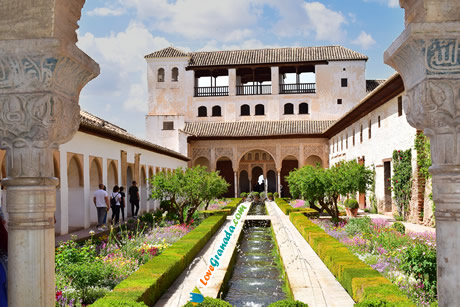 Once a peaceful retreat for the sultans, it offers breathtaking views of both the
city and the Sierra Nevada mountains.
Once a peaceful retreat for the sultans, it offers breathtaking views of both the
city and the Sierra Nevada mountains.
At the heart of the Generalife lies the Patio de la Acequia, where a long irrigation channel runs through the center, flanked by symmetrical fountains and surrounded by green vegetation. From the gallery, framed by arches that open to the city, the views are simply incredible.
Take a stroll through the Sultana Garden, the Abencerrajes Garden, each with its own beautifully symmetrical layout that provide both beauty and a refreshing escape.
- There are tickets available only for the the Generalife and the Alcazaba. If you're mainly interested in enjoying the gardens and the views from the Alcazaba towers, and don't wish to visit the Nasrid Palaces, you can opt for this more affordable option.
The Alcazaba
The Alcázaba military area is situated at the highest point of Sabika Hill. Its strategic location allowed it to oversee and control both the city and the surrounding valley.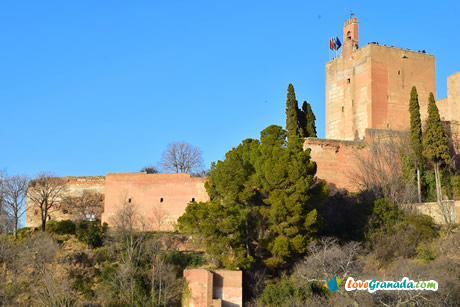 This imposing complex of towers, walls, and courtyards is one of the oldest sections of the Alhambra,
originally built to defend the Nasrid kingdom.
This imposing complex of towers, walls, and courtyards is one of the oldest sections of the Alhambra,
originally built to defend the Nasrid kingdom.
Within its walls stand the Torre de la Vela (Torre=>Tower), an iconic symbol of the city known for its panoramic views, and the Torre del Homenaje, which served as a refuge for the governor during times of siege.
Inside the Alcazaba, the Plaza de Armas served as the soldiers' living quarters and provided essential services for the garrison.
Some Recommendations
- Keep in mind the Alhambra can easily take up most of the morning, and you'll likely have little time for anything else before lunch.
- Purchase tickets in advance: It is crucial to purchase your tickets to the Alhambra ahead of time, as they tend to sell out quickly, especially during peak seasons.
- Buy from the official website: Tickets should be purchased through the official Alhambra website. Third-party sites may charge additional fees and offer guided tours that you may not need. If you'd rather have a guided tour, here's a link to one that covers everything and has very good reviews: Alhambra Guided Tour.
Carmen de los Mártires – Historic Estate and Gardens
If you have time before lunch, after exploring the Alhambra and the Generalife, we recommend visiting the Carmen de los Mártires, which is just a short walk away.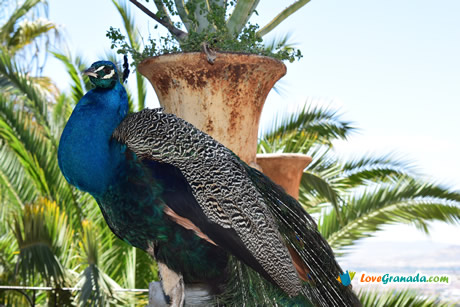 This romantic garden, with its peaceful lakes, fountains, and stunning views of the city, is a real find.
This romantic garden, with its peaceful lakes, fountains, and stunning views of the city, is a real find.
Situated on the hill of the Alhambra, this historic site blends Renaissance, Islamic, and Baroque styles, a great spot to take a peaceful stroll.
Throughout history, the Carmen de los Mártires has served both as a convent and as a residence for nobles.
From either the Alhambra or Carmen de los Mártires, you can follow Cuesta de Gomérez, a picturesque path that leads directly to Plaza Nueva, the quickest route to the heart of Granada. Or, you can just take the bus if you want a quick and easy ride.
- Carmen de los Mártires is a short 5 minutes from the Alhambra, passing through the forest and the Puerta de las Granadas gate.
- The gardens are closed from 2:00 PM to 4:00 PM on weekdays, and close at 6:00 PM in winter.
Plaza Nueva – Heart of Granada
Plaza Nueva (New Square) doesn't quite match its name, as it's actually is one of the oldest and most significant squares in Granada, making it an ideal starting point for exploring the city.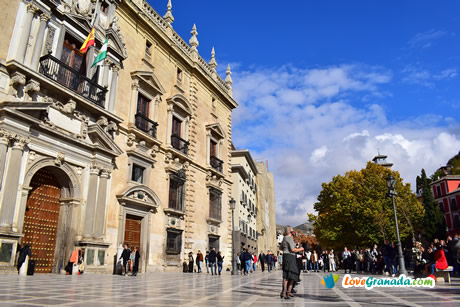 In Plaza Nueva, several buildings stand out for their architectural beauty and historical significance.
Among them is the Real Chancillería, a Renaissance-style building that once served as
Granada's first Court of Justice during the reign of the Catholic Monarchs.
In Plaza Nueva, several buildings stand out for their architectural beauty and historical significance.
Among them is the Real Chancillería, a Renaissance-style building that once served as
Granada's first Court of Justice during the reign of the Catholic Monarchs.
Nearby stands the Church of Santa Ana, notable for its captivating blend of Gothic and Renaissance architectural elements.
Just next door stands a true masterpiece by Diego de Siloé: the Pilar del Toro, an impressive 16th-century fountain. This spot marks the beginning of the famous Carrera del Darro, one of the most picturesque streets in Granada.
- In Plaza Nueva you can find musicians and flamenco dancers, especially in the afternoons. It's a great opportunity to experience this local tradition.
Time to Eat
- If you're ready for lunch or tapas, Calle Elvira is an excellent choice. With a wide variety of bars and restaurants, you'll find plenty of delicious options to enjoy.
- Find more information in the section dedicated to restaurants and bars of Granada.
Carrera del Darro – Scenic Path Along the River Darro
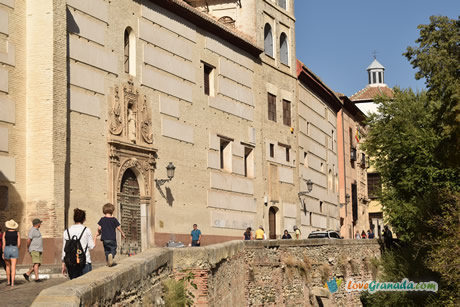 After lunch, we continue our walk along Carrera del Darro, one of
the most picturesque and iconic streets in Granada. Stretching alongside the Darro River,
it's an ideal spot for a pleasant walk, offering breathtaking views of the Alhambra rising on the hillside.
After lunch, we continue our walk along Carrera del Darro, one of
the most picturesque and iconic streets in Granada. Stretching alongside the Darro River,
it's an ideal spot for a pleasant walk, offering breathtaking views of the Alhambra rising on the hillside.
As you follow the Carrera del Darro, you'll come across several points of interest, each with its own unique story to tell.
The Cabrera Bridge, which spans the river, connects the historic center to the charming neighborhood of Albaicín.
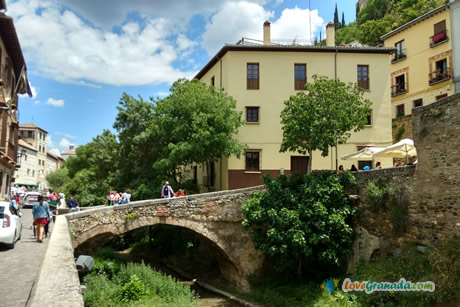 The Convent of Santa Catalina de Zafra is a striking example of blended Islamic and Christian architectural influences.
The Convent of Santa Catalina de Zafra is a striking example of blended Islamic and Christian architectural influences.
The Bañuelo is an ancient Arab bathhouse dating back over a thousand years, built during the reign of the Nasrid kings. People came to The Bañuelo not just to bathe, but also to relax and socialize with friends.
The walk along Carrera del Darro ends where the Paseo de los Tristes begins, offering even more breathtaking views of the Alhambra.
- On Sundays, admission to the Bañuelo and other monuments in Dobla de Oro is free for residents of the European Union.
Paseo de los Tristes – Scenic Walk with Alhambra Views
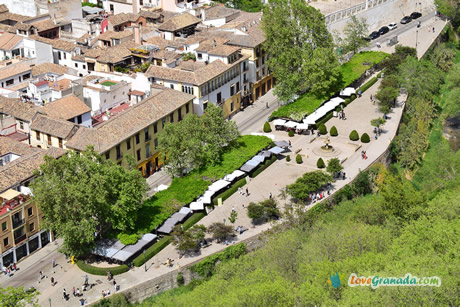 Paseo de los Tristes is a picturesque square-shaped street in Granada,
located at the foot of the Alhambra and alongside the Darro River.
Paseo de los Tristes is a picturesque square-shaped street in Granada,
located at the foot of the Alhambra and alongside the Darro River.
This charming street, which runs along the riverbank, offers beautiful views of the Alhambra. The name (literally: the Promenade of the Sad) is thought to originate from a time when this path led to the cemetery.
As you walk along the Paseo de los Tristes, you'll pass several historic landmarks, including the Casa y Puente de las Chirimías (House and Bridge of the Chirimías) and the Puente del Aljibillo (Aljibillo Bridge).
 Along the way, you'll also find a variety of terraces and cafés where you can relax, enjoy a drink and
the spectacular views of the Alhambra.
Along the way, you'll also find a variety of terraces and cafés where you can relax, enjoy a drink and
the spectacular views of the Alhambra.
At the end of the Paseo de los Tristes, we begin our ascent to the Albaicín. The slope is steep, so it's advisable to take the bus up and save your energy for the descent.
For those who prefer less walking and want to explore Granada's rich history and architecture, a visit to the nearby Cathedral and Royal Chapel is a fantastic alternative.
- The outdoor terraces of Paseo de los Tristes are a good place to enjoy a refreshing drink served with 'tapa', and the views, but it might be better to find a less touristy spot for lunch.
The Albaicín - Granada's Historic Moorish Quarter
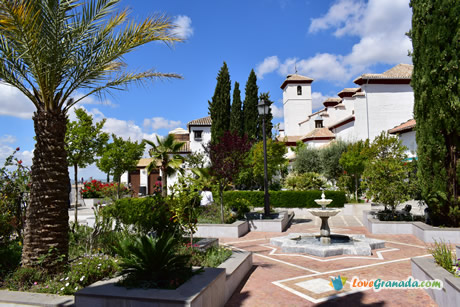 A walk through Albaicín, Granada's old Moorish quarter
feels like going back in time. As you explore the neighborhood, you'll find yourself surrounded by narrow streets and corners filled
with history.
A walk through Albaicín, Granada's old Moorish quarter
feels like going back in time. As you explore the neighborhood, you'll find yourself surrounded by narrow streets and corners filled
with history.
It's a lovely, romantic place, perfect for watching the sunset from the San Nicolas Viewpoint while street musicians play their music in the background.
One of the many highlights of Albaicín is its cármenes, traditional houses with private patios and gardens. These charming rustic houses beautifully blend classic architecture of Granada with the distinctive character of the neighborhood.
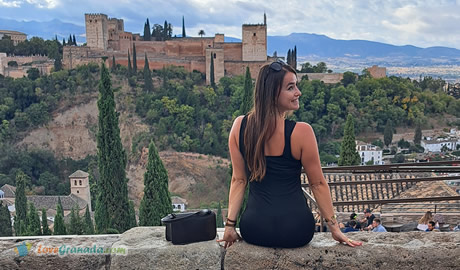 A visit to the Church of San Salvador is highly recommended. Built on the site of a former mosque,
it offers a fascinating glimpse into the city's layered history.
A visit to the Church of San Salvador is highly recommended. Built on the site of a former mosque,
it offers a fascinating glimpse into the city's layered history.
Another notable site is the Dar al-Horra Palace, which once served as the residence of the mother of the last Nasrid king of Granada.
And don't forget to check out the many other viewpoints as well such as Mirador de San Cristobal, Carvajales, or San Miguel Alto.
- When exploring Albaicín, be sure to wear comfortable shoes as the streets are cobbled and often quite steep.
- Climbing the hills on foot during the summer heat is not recommended, taking the bus is definitely the better option.
- Small city buses run directly from Plaza Nueva or Paseo de los Tristes to the Mirador de San Nicolás.
Sacromonte - Caves, Flamenco and Stunning Views
If you have time, be sure to visit Sacromonte, one of Granada's most iconic neighborhoods. Known for its caves carved into the rock, Sacromonte has a truly unique atmosphere.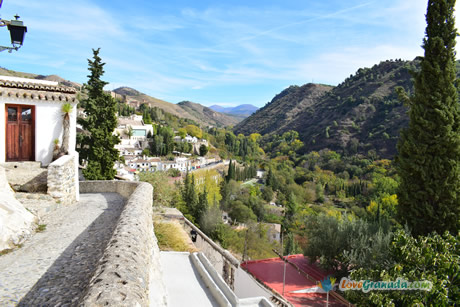 For centuries, many Gypsy communities have lived here, preserving traditions such as the zambra and
other flamenco dances that are key to Granada's cultural heritage.
For centuries, many Gypsy communities have lived here, preserving traditions such as the zambra and
other flamenco dances that are key to Granada's cultural heritage.
At the heart of Sacromonte stands the Sacromonte Abbey, a historic site that includes a monastery, chapels, sacred caves, and offers panoramic views of the surrounding area.
While it may not be open for visits if you come in the evening, you can still admire its impressive exterior and the views of the Alhambra. From Sacromonte, you'll also enjoy breathtaking views of both the city and the mountains.
- The Sacromonte is a big neighborhood, if you enjoy walking and have the time, we recommend heading to the abbey on foot. It's approximately a 2-hour round trip starting from Plaza Nueva, but you can also come back to the center by bus.
Flamenco Shows - Experience Pure Passion
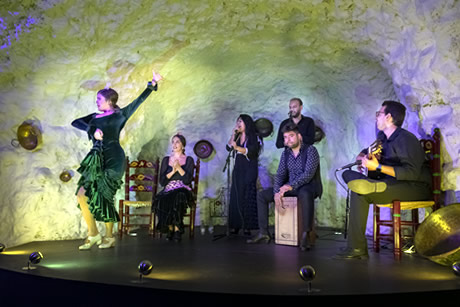 Flamenco is an integral part of Sacromonte's identity,
As you explore the neighborhood, you'll discover flamenco caves and tablaos dedicated to live performances.
Flamenco is an integral part of Sacromonte's identity,
As you explore the neighborhood, you'll discover flamenco caves and tablaos dedicated to live performances.
The shows are full of passion and energy and capture the spirit of flamenco, one of Spain's most powerful artistic expressions.
Since these performances typically begin between 9:00 and 10:00 p.m., they make for the perfect evening activity to complement your day.
- If you want to experience an authentic flamenco show in Sacromonte, these are some of the best-rated flamenco tablaos in Granada: Flamenco Tablao Jardines de Zoraya or Flamenco Show La Alboreá.
Arab Baths - Traditional Spa Experience
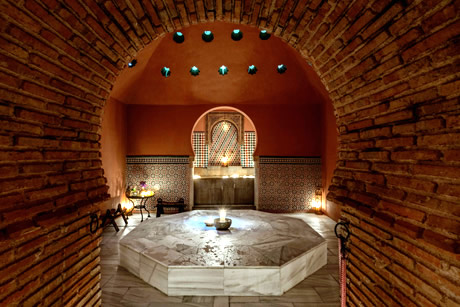 If flamenco doesn't suit your taste, , another great way to unwind is by visiting the
Arab baths or hammam, where you can
relax and recharge.
If flamenco doesn't suit your taste, , another great way to unwind is by visiting the
Arab baths or hammam, where you can
relax and recharge.
Afternoon sessions are available, but reservations are highly recommended, as these places are quite popular and space is limited.
You'll find several pools with different temperatures, cold, warm, and hot, plus a steam room (hammam) and special pools like the aromatherapy pool.
You can also complement your visit with a massage, which can last from 15 to 60 minutes, and choose from various specialty treatments.
- Here is one of the best arab baths in Granada: Hammam Arab Baths. It's best to book in advance, as they are very popular and capacity is limited.
Granada Day Two Plan: Best Places to See and Things to Do
On your second day in Granada, if you didn't choose to see it on day one, you should definitely check out the magnificent Cathedral and Royal Chapel.
The Cathedral - Stunning Gothic-Renaissance
The Granada Cathedral is a remarkable example of the transition between late Gothic and Renaissance styles in Spain. It was built on the site of the city's former main mosque following the capture of Granada in 1492.
While initially planned in the Gothic style, the construction was ultimately completed in the Renaissance style.
It was built on the site of the city's former main mosque following the capture of Granada in 1492.
While initially planned in the Gothic style, the construction was ultimately completed in the Renaissance style.
The Cathedral was supposed to have two towers, each reaching 81 meters. However, only one tower was completed, standing at 57 meters, and it was built with just three of the six planned floors due to foundation issues.
The largest bell in the cathedral weighs over six tons and has a diameter of two meters, making it the largest bell in Granada.
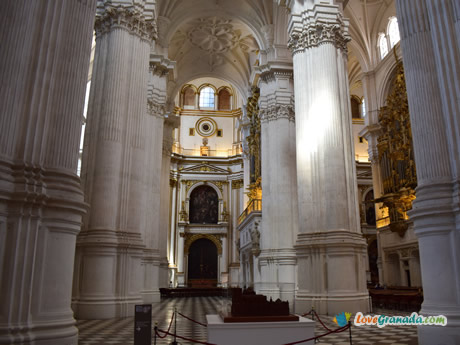 Inside, the cathedral has several naves, with tall columns and a high ceiling that gives a strong sense of greatness.
Inside, the cathedral has several naves, with tall columns and a high ceiling that gives a strong sense of greatness.
Diego de Siloé designed the unique high altar in the central chapel. Unlike traditional altars, it has no altarpieces, or railings. Instead, a single block, about 3 meters long, positioned at the center of an open spot, it allows people to gather around.
Beneath the central part of the cathedral is the underground crypt, where Mariana Pineda, the most iconic symbol of freedom in Granada, is buried. Known for her resistance, Pineda was immortalized by Federico García Lorca in a play written in her honor. Her tomb can only be visited on All Souls' Day and on the anniversary of her death.
- Don't forget to visit the Tabernacle Church of the cathedral, which has a separate entrance and is free.
- If you have the Granada Card, just show the QR code at the entrance to the Cathedral or the Royal Chapel.
Royal Chapel - Burial Site of the Catholic Monarchs
Next to the Granada Cathedral is the Royal Chapel, a Gothic-style building with great historical importance.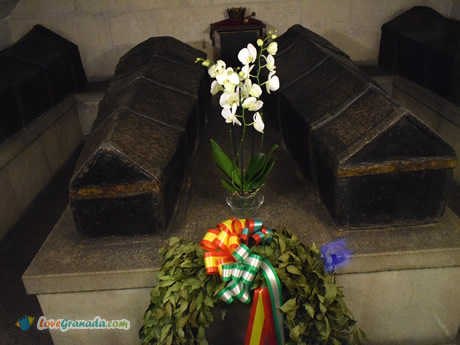 It holds the remains of Catholic Monarchs,
Isabella I of Castile and Ferdinand V of Aragon, who played a key role in
Spain's history.
It holds the remains of Catholic Monarchs,
Isabella I of Castile and Ferdinand V of Aragon, who played a key role in
Spain's history.
The altar and the frescoes on the walls make the visit even more special. Inside the Royal Chapel, you can see valuable works of art and religious objects. The Sacristy also serves as a museum, preserving much of the legacy of the Monarchs.
Among the treasures kept here are Flemish paintings from the queen's collection, works by Botticelli, and personal luxury items, such as the queen's reliquary and the king's sword.
Both the Cathedral and the Royal Chapel offer deep insights into Granada's rich history and are must-visit sites when exploring the city.
- Tickets for both the Cathedral and the Royal Chapel can be purchased online, though it's not essential, as they are usually available at the ticket office on the same day.
- If you have the Granada Card, simply show the QR code at the entrance.
- Plan to spend about 2 to 3 hours exploring both sites.
There are several other interesting places near the Cathedral, making it a great opportunity to explore the surrounding area further. We recommend visiting the following four places, which can be seen in about 1 to 2 hours: La Madraza, The Alcaicería, Plaza Bib Rambla, Corral del Carbón.
The Madraza - Granada's Ancient University
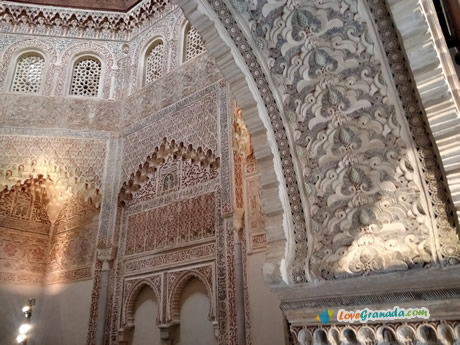 The Madraza was the first and only public
university in all of Al-Andalus, and it stayed open until 1499. It taught a wide range of subjects, including math,
astrology, chemistry, physics, and medicine.
The Madraza was the first and only public
university in all of Al-Andalus, and it stayed open until 1499. It taught a wide range of subjects, including math,
astrology, chemistry, physics, and medicine.
Founded in 1349 by Yusuf I, it's the only one of its kind still standing in the entire Iberian Peninsula.
Only the oratory remains from the original structure, with a stunning mihrab and an octagonal dome. After the Christian conquest of Granada, the Madraza was turned into the city hall, and the second floor—along with the beautiful Knights' Hall—was added.
- Unfortunately, the oratory isn't open to visitors for conservation reasons, it's closed off with a barrier, but you can still glance inside.
The Alcaicería - Traditional Medieval Market
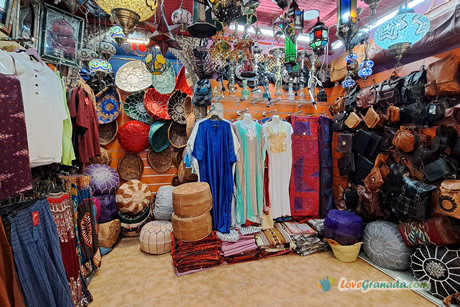 Founded in the 16th century, the The Alcaicería was once a
busy trading center for valuable goods like silver, silk, and other items that could only be sold there.
Founded in the 16th century, the The Alcaicería was once a
busy trading center for valuable goods like silver, silk, and other items that could only be sold there.
The original structure was destroyed by fire in the 19th century. Today, it's both a tourist attraction and a lively commercial spot.
Inside the Alcaicería, you'll find plenty of traditional Andalusian and Moorish-style crafts, and gifts for sale, though not all of them are unique to Granada, so choose carefully.
- As you make your way through the La Alcaicería, you'll come right to Plaza Bib Rambla, our next stop.
Plaza Bib Rambla - City's Social Center
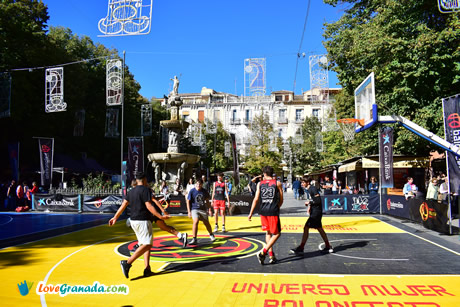 Plaza Bib Rambla, located in the heart of Granada, is a charming
square surrounded by historic buildings, cafés, and restaurants—some of which welcome tourists. In the past,
it served as the city's main social and commercial hub.
Plaza Bib Rambla, located in the heart of Granada, is a charming
square surrounded by historic buildings, cafés, and restaurants—some of which welcome tourists. In the past,
it served as the city's main social and commercial hub.
It was the site of many important public events, like tournaments, festivals, and even bullfights.
One of the square's most distinctive features is the Fuente de los Gigantones fountain, decorated with four unique figures. For a sweet treat, be sure to stop by the the Alhambra chocolate shop, where you can enjoy their popular churros served with thick dipping chocolate.
- If you're lucky, you'll find traditional markets, sports competitions, or shows happening in the square.
Corral del Carbón - Medieval Trade Hub
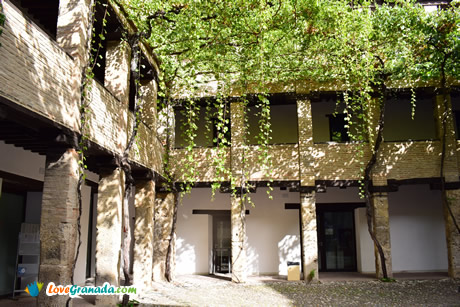 The Corral del Carbón is the only fully preserved corn exchange facility
in Spain, dating back to the 14th century. It originally served as a grain store, a storage space for goods,
and a refuge for merchants.
The Corral del Carbón is the only fully preserved corn exchange facility
in Spain, dating back to the 14th century. It originally served as a grain store, a storage space for goods,
and a refuge for merchants.
In the 17th century, it was repurposed as lodging for coal merchants and later became a tenement house, housing up to 36 families. The building is square-shaped, with a grand entrance featuring a large horseshoe arch and a stunning muqarnas dome.
- The Corral del Carbón is included in the Granada Card, but it's free to visit anyway.
Time to Eat
By now, it's probably lunchtime, and there are plenty of great spots nearby
where you can grab a meal. Here are some recommendations:
- El Mercader – offering a mix of international and Mediterranean dishes.
- Habibi Comida Casera – perfect for those who enjoy kebabs and prefer a casual, grab-and-go option.
- La Puerta de Siria – a must-visit for fans of Arabic cuisine.
- Mercato Italiano – ideal for anyone looking to enjoy Italian food and pizza.
- For a sweet treat, make sure to stop by Los Italianos, just behind the Cathedral, across Gran Vía, for some delicious ice cream.
Monastery of San Jerónimo - Rich Collection of Art
 Just a 10-15 minute walk from the Cathedral, the Monastery of San Jerónimo
is a must-see on your visit.
Just a 10-15 minute walk from the Cathedral, the Monastery of San Jerónimo
is a must-see on your visit.
Founded in 1492, the same year the Catholic Monarchs completed the conquest of Granada, its construction was finished in 1542.
In the early 19th century, Napoleonic troops occupied the monastery, and stones from the bell tower were used to build the Puente Verde bridge over the Genil River. Despite the damage, the monastery's beautiful cloister and church have been preserved.
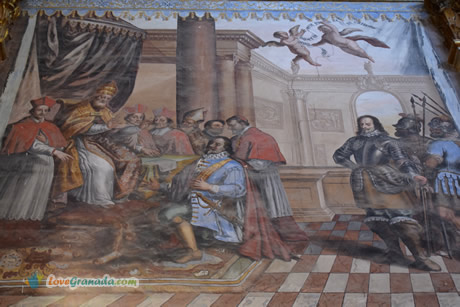 The cloister, with its elegant columns and peaceful courtyards, really captures the spirit of the place. The church is a
highlight, especially the magnificent altarpiece in the Main Chapel and the vibrant colors decorating its interior.
The cloister, with its elegant columns and peaceful courtyards, really captures the spirit of the place. The church is a
highlight, especially the magnificent altarpiece in the Main Chapel and the vibrant colors decorating its interior.
During the 16th and 17th centuries, the Monastery of San Jerónimo was one of the wealthiest in Spain, thanks to its vast lands and generous donations. This wealth allowed it to build an impressive collection of art and valuable objects.
- The Monastery of San Jerónimo is located near the city center. You can take a bus, however, taking a pleasant 10-minute walk is a better choice.
Cartuja Monastery - Rich Architectural Diversity
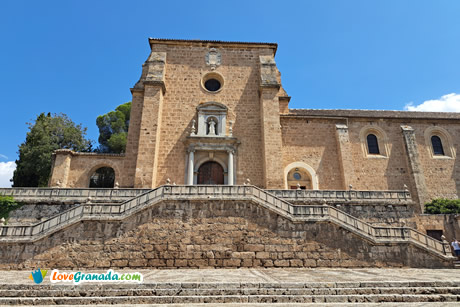 If you're spending two days in Granada, the 20-minute bus ride to the
Cartuja Monastery is definitely worth it.
This historic site is one of Granada's lesser-known sites, but should not to be missed.
If you're spending two days in Granada, the 20-minute bus ride to the
Cartuja Monastery is definitely worth it.
This historic site is one of Granada's lesser-known sites, but should not to be missed.
Founded in 1529, the Cartuja Monastery was originally created as a retreat for the Carthusian monks, who focused on solitude and dedicated themselves fully to prayer and meditation.
Construction of the monastery started in the early 16th century and took over three centuries to complete, mainly because of money issues and the complicated design.
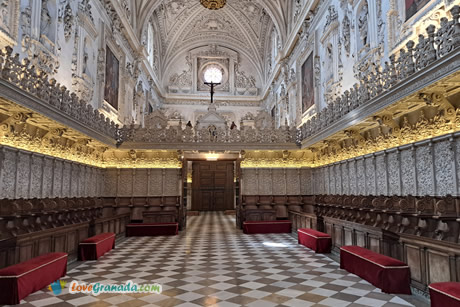 The monastery mixes different architectural styles like Renaissance, Baroque, and Gothic. It balances the simple,
austere look of the cloister and chapter house with parts that are richly and carefully decorated.
The monastery mixes different architectural styles like Renaissance, Baroque, and Gothic. It balances the simple,
austere look of the cloister and chapter house with parts that are richly and carefully decorated.
Some of the highlights include the sanctuary and sacristy, both beautiful examples of Spanish Baroque. The monastery church stands out, especially its main altar with an altarpiece of great artistic value.
- You'll find QR codes around the monastery for the audio guide, so it's a good idea to bring headphones to make the most of your visit.
- From Gran Vía, just behind the Cathedral and across from Los Italianos, you'll find a bus stop for bus number 8 that will take you directly to the monastery.
- Alternatively, you can drive there, as free parking is available right on site.
Tapas Time - Unique Culinary Experience
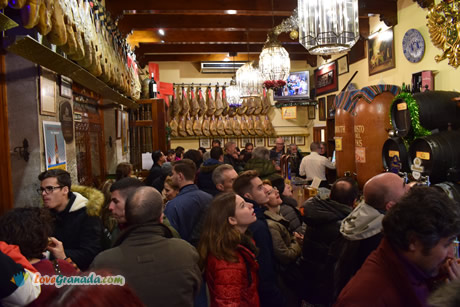 Now it's time to enjoy the delicious food of Granada.
Now it's time to enjoy the delicious food of Granada.
In Granada, it's common to skip a formal meal and try some tapas instead. Rather than sitting down for a traditional lunch or dinner, you can hop between bars in the city center, order a drink at each stop, and enjoy the tapas that come with it.
It's a fun and immersive way to sample a variety of local dishes while soaking up the city's lively atmosphere. An authentic food experience you definitely won't want to miss!
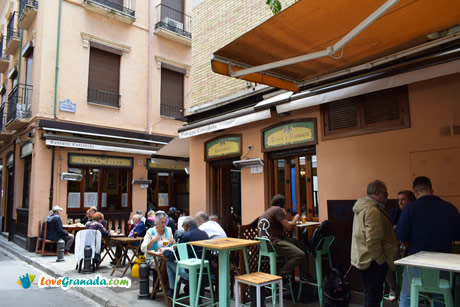 Here are 5 recommended spots in Granada to enjoy traditional tapas and local cuisine,
each with its own unique charm.
Here are 5 recommended spots in Granada to enjoy traditional tapas and local cuisine,
each with its own unique charm.
Bodegas Castañeda
A Granada classic, known for its traditional vibe. This spot offers a wide variety of local favorites, including jamón, montaditos, and regional cheeses. Just steps from the Cathedral.Los Diamantes
 Well-known for its fresh, fried seafood tapas, this place is a must for fish lovers. It's a favorite among both
locals and tourists, thanks to its tasty and generous portions. This bar has multiple locations, one of them is
just minutes from Plaza Nueva.
Well-known for its fresh, fried seafood tapas, this place is a must for fish lovers. It's a favorite among both
locals and tourists, thanks to its tasty and generous portions. This bar has multiple locations, one of them is
just minutes from Plaza Nueva.
La Tana
If you're a wine lover, La Tana is the place to be. This cozy tavern offers an impressive selection of local and international wines, paired with top-quality tapas like artisanal cured meats and cheeses. Located near Mairana Pineda Square.La Auténtica Carmela
 For homemade tapas, La Auténtica Carmela is the go-to spot. They offer everything from comforting stews to crispy fried
dishes in a welcoming, laid-back atmosphere, making it the perfect place to enjoy authentic local cuisine.
A short walk from Isabel la Católica Square.
For homemade tapas, La Auténtica Carmela is the go-to spot. They offer everything from comforting stews to crispy fried
dishes in a welcoming, laid-back atmosphere, making it the perfect place to enjoy authentic local cuisine.
A short walk from Isabel la Católica Square.
Bar Poë
For creative, modern tapas, Bar Poë is a must. The dishes put a fresh spin on Granada's traditional flavors, and the unique décor and cozy vibe make it a favorite with locals. Just a 5-minute walk from Recogidas Street.More Information
A part from the 2-day Granada itinerary, you can also find additional information in
monuments,
attractions, and
museums, so you can swap out any
above mentioned sites for others that better match your interests.
If you're staying in Granada for one day or three days, please check Granada in 1 Day, and Granada in 3 Days.
There's also practical info on getting around by bus, train, taxi, metro, and more.
Page Updated: Nov 30, 2025
Was this useful? Been to these sights? Share your thoughts!
© Copyright •
LoveGranada.com • Any use of the content, including copying of it in whole or in part is prohibited.
You Might Also Be Interested In
Opinions about Granada in Two Days
Use public transport or walk
It’s small enough to walk everywhere. You don’t need a car, unless you’re planning to go the the beach or the mountains, public transport or taxis cover most of what you'd need. Wear comfy shoes.
It's great for a 2–3 day trip, enough time to see the sights. The Alhambra is obviously a must. Book Alhambra tickets early.
Flamenco and the Alpujarra
If you're into local flavor, visit the Sacromonte, especially in the evening. Apart from the amazing views of the Alhambra, the caves and flamenco shows there are passionate, and deeply tied to Granada’s traditions. Even if flamenco isn’t your thing, it’s hard not to be moved.
If you’ve got extra time, I’d recommend visiting the little white villages in Las Alpujarras. Totally different vibe, more nature, fewer people, amazing views.
Exploring Granada at a Relaxed Pace
Granada stole our hearts. It’s a city meant to be explored slowly, savoring every moment.
We spent two fantastic days in Granada. On the first day, we visited the Alhambra and wandered through the Carrera del Darro and the Albaicin, with its narrow, charming streets. We enjoyed delicious tapas on Calle Elvira, which had a great atmosphere.
On the second day, we visited the Cathedral, Royal Chapel and several monasteries. Recommendation: book tickets for the Alhambra online in advance and wake up early to avoid the crowds.

